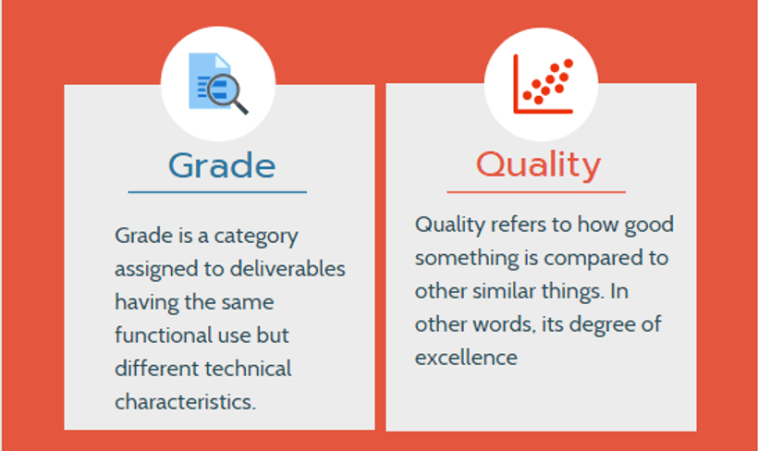Episode 08 - How to get into project management without experience? Part 3 of 3 - Volunteer

Quality vs Grad
Grade and Quality terms are widely used in Project Quality Management as well as in our daily life. Both terms imply establishing or meeting standards but they are not interchangeable. Professionals may sometimes misunderstand their differences and mistakenly use them synonymously. They are not difficult terms to understand, we simply need to pay them a bit more attention.
Quality
Quality is the degree to which the product / result / project meets the customer or end-user requirements. On the other hand, quality refers to the overall standard or excellence of the project, including the quality of the deliverables produced, the processes used to complete the project, and the outcomes of the project.
In simple terms, high-quality product means the product that meets the quality requirements established in the product specification.
Note: Since end-user requirements may or may not be in alignment with the documented requirements, or so called “specification”.
You should not mix the concepts of Quality with Grade. Quality means how well the output aligns with the client’s needs and expectations.
- High quality: the deliverable matches its expected specifications. There are no defects, and it functions correctly.
- Low quality: the deliverable does not fulfill requirements. It has defects or does not work well or at all.
Grade
The PMBOK Guide, defines the word grade as “a category assigned to deliverables having the same functional use but different technical characteristics.” In simple terms, the grade is a category assigned to the product based on its technical configuration and is usually determined through some set of pre-determined measurements and demonstration of compliance to those measurements.
- High grade: many valuable or desired features.
- Low grade: limited or undesirable features.
MUST KNOW Concept: Grade vs Quality
- Low quality does not refer to a low-grade product, high quality does not refer to a high-grade product.
- Grade is related to technical features. Therefore, a low-grade product can be acceptable. However, quality is related to meeting the customer’s requirements. Therefore a low-quality product cannot be acceptable.
Real World Example
Let’s say you buy a basic model (low-grade) cellphone. It doesn’t have any advanced features, but it works well. It never gives you any trouble, always works flawlessly, and it is defect free — no problem at all.
So, you can say that this is a high-quality product. Although it is a low-grade, it keeps you happy and satisfied.
Now, suppose you buy another costly premium model (high-grade) cellphone. This phone has all the advanced features: touch screen, Wi-Fi, Bluetooth, camera, voice, and face recognition.
But how would you feel if the product did not perform well?
- The touch screen freezes while you are using the phone.
- The camera does not give you good, stable pictures.
- The voice system does not recognize you most of the time.
This is frustrating because you spent a lot of money on a high-grade product that does not perform well. Despite the price, it is of low quality and that is not acceptable.
Summary
A product can be a low grade but it can meet the quality requirements. On the other hand, it is possible that a high-grade product may not meet the quality requirements. High grade does not imply high quality and low grade does not imply low quality.
As a project manager, the quality of all product / result / project must be stated, regardless of the grade. A good-quality product / result / project may initially take time and money but it gives enormous benefits including reduction in time, money and effort.
Here is where this grade vs quality post comes to an end. I hope that now you have a clear understanding of grade and quality. If you have anything to share or any questions, you can do so in the comments section below, or reach Fanbit Consulting.
